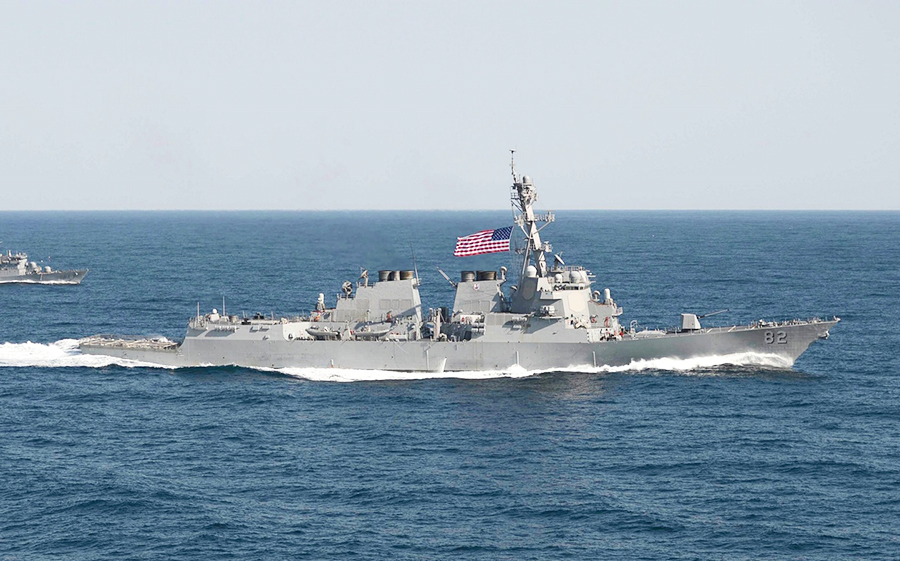Since last year, the US has dispatched military aircraft and vessels into the airspace and seas surrounding Chinese islands and reefs in the South China Sea to conduct so-called ‘freedom of navigation’ (FON) operations. The operations are out of triple political considerations targeting China, China’s neighbors and US itself.

USS Lassen went on patrol around the disputed Spratly archipelago. Photograph: Us Navy/Reuters
First, the operations are a declaration of a tough stance. ‘Freedom of navigation’ has been an excuse used by the US for taking action against countries with ‘excessive maritime claims’. It originated from the FON program introduced by the Carter Administration in 1979. The program was designed to maintain the ‘maritime freedom’ of the US and prevent coastal states from challenging America’s position as a maritime power with their excessive claims, thus ensuring global mobility of its military forces.
Since inception of the program, the US has conducted diplomatic protests and declaratory military actions against over 30 countries and regions on hundreds of occasions. These countries included not only so-called adversaries of the US but also allies, including the Philippines and Thailand. China is a major target of the FON program, with the US challenging China’s ‘excessive maritime claims’ on dozens of occasions. Nonetheless, no matter which country is the target, FON operations tend to be low-key and some are even conducted without notifying the target country of operational details. However, the recent FON operations in the South China Sea have been rather public, even with deliberate leaks of information to the media to hype the situation. This is rather high-profile and provocative: The true intention is to declare to China America’s determination to maintain its dominance in the Asia Pacific.
Last year the Philippines sought arbitration on South China Sea, and China took a series of actions in safeguarding its maritime rights and interests, with periodic gains. Against this backdrop, by flexing its muscle, stating its position and exerting pressure on China, the US has clearly adopted more public, high-profile, targeted and tougher measures to ‘resist’ China’s attempt to ‘change the status quo’.
Second, the operations lend support to Vietnam, the Philippines and other countries that have maritime disputes with China. The US knows it well that it is impossible to stop China’s activities in the South China Sea with these actions. However, the FON operations may serve as a nice diplomatic tool to pacify disputants over the South China Sea and the few countries who wish to see the US play a greater role in the Asia Pacific. Vietnam and the Philippines have realized that their vested interests can not be defended by themselves alone and that it’s impossible for them to counter the increasing power and operations of China in disputes over the South China Sea. Therefore, they have to draw support from the US and they ardently pursue comprehensive help from the US. In this connection, the US has allowed the traditionally low-key FON operations to be as overhyped as Hollywood movies, thus achieving an open policy shift from ‘neutrality in appearance, command behind the scene’ to ‘open intervention, direct confrontation’ to back up Vietnam and Philippines and to confront China in the South China Sea.
Finally, the operations are also aimed at gaining political initiative at home. China has very much been a tool of domestic political competition in the US. In recent years, financial difficulties have placed much constraint on the formulation and implementation of national strategies in the US, with fierce competition among different interest groups. As the US sets to readjust its strategic defense plan and defense budget, the military-industrial complex tends to hype the China issue, the China threat in particular, so as to protect vested interests and seize a bigger ‘cake’. The American military deliberately exaggerates China’s ‘aggressiveness’ and demonstrates an image of valiance through FON operations. As the Obama Administration go into its final months, the question of ‘political legacy’ has become central. As an important part of America’s policy towards the Asia Pacific, the South China Sea issue is regarded as an essential component of Obama’s political legacy, thus gaining more attention. A good performance of these operations helps consolidate Obama’s political legacy and adds luster of his record.
Differences over freedom of navigation mainly originate from different interpretations of UNCLOS. The US hopes to expand the bounds of FON, enlarging the scope of activities by its maritime forces with global military mobility. As China extends the reaches of its maritime power, the operational capability at sea of the PLA Navy may be constrained due to the question of EEZ jurisdiction. In this connection, China and the US will have increased shared concerns in this regard. China should consider developing cooperation with the US at appropriate times. For example, China may, in the name of safeguarding freedom of navigation in the South China Sea, invite the navies of the US and other countries to join the PLA Navy in joint military exercises or joint patrols. By so doing, the two countries may gradually develop a common language on freedom of navigation.



